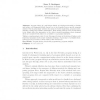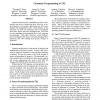828 search results - page 13 / 166 » A New Model of Program Dependences for Reverse Engineering |
SAC
2009
ACM
14 years 2 months ago
2009
ACM
Ubiquitous computing and service-oriented computing enable the development of a new trend of applications that can opportunely interact with services discovered in the surrounding...
COMPSAC
2004
IEEE
13 years 11 months ago
2004
IEEE
Software reliability is defined as the probability of failure-free software operation for a specified period of time in a specified environment. Over the past 30 years, many softw...
IGPL
2010
13 years 6 months ago
2010
In this paper we present a new model for the requirements analysis of a system. We offer a conceptual model defined following a visual modeling language, called dependence network...
JUCS
2007
13 years 7 months ago
2007
: Program slicing is a well known family of techniques intended to identify and isolate code fragments which depend on, or are depended upon, specific program entities. This is pa...
SCAM
2002
IEEE
14 years 17 days ago
2002
IEEE
Syntactic analysis forms a foundation of many source analysis and reverse engineering tools. However, a single grammar is not always appropriate for all source analysis and manipu...


